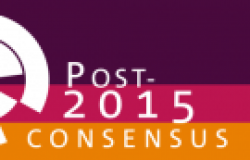Maintaining Poverty Reduction Post-2015

The Copenhagen Consensus Center has just released its latest research on Poverty targets for the post-2015 development agenda.
Extreme poverty – or living on less than $1.25 a day – is a continuing problem for far too many people today. In Nigeria for instance, such poverty still afflicts about 62 million people, according to the World Bank.
It is also arguably one of the most important challenges to address because more prosperous people can afford more to eat, get better access to education and healthcare, and generally live better lives. So it’s good to see that excellent progress has been made in poverty reduction in recent years. The proportion of people in developing countries living in poverty more than halved between 1990 and 2010.
Globally, according to the World Bank, just over one billion people continue to live in poverty, although that’s down from 1.9 billion in 1990. The big question now is whether this rapid improvement can be maintained so that we can truly make poverty history.
The obvious solution is probably not to address poverty head-on but focus on another policy that could help dramatically: free trade. The costs of successfully completing the Doha round of World Trade Organization talks would generate more than 2,000 times their value in benefits for developing countries and lift 160 million out of poverty.
However, this policy has also turned out to be very hard to implement, and Doha is languishing.
John Gibson, Professor of Economics, Waikato University points out that already for the MDGs in 2000, a number of targets were assessed and rejected in favor of a simple one: halving the rate of absolute poverty. He argues that this kind of target is still the most sensible one.
However, any target can sound deceptively simple but measuring progress – or even setting a reliable baseline – can be fraught with difficulty. Collecting reliable statistical data is almost impossible in countries with little survey infrastructure, the very places where poverty is still a big problem. And, if we can’t measure it, we don’t know if resources are being used properly.
The best which can be done is to take figures where they are available and draw whatever broader lessons we can. This is possible for Vietnam, which has made astonishing progress in recent years. In 1993, 64% of the population were below the poverty line; by 2010 this had fallen to just 5%. The benefits are wide-ranging. Not only are people earning more and have better access for good nutrition but more prosperous people are typically better educated, live longer and can make a bigger contribution to the wider economy. We can estimate the lowest cost for taking people out of poverty as the sum of money needed to plug their poverty gap. It turns out that each dollar transferred pays back 6-9 dollars in overall benefits, both measured in increased longevity, better education and higher incomes.
This, however, assumes that money can be perfectly targeted but this is an impossible task. Some of the money will be misused and some lost, so the true payback may be reduced by half, to perhaps 4-6 dollars for each one spent. The other important point is that the tremendous progress made in a range of East Asian countries (including Vietnam) in the recent past is due to a number of factors unlikely to come together elsewhere.
Poverty is an undeniably complex issue but experience shows that plenty can be done. Free trade, for one, can boost the growth of developing economies and provide more jobs. Freer migration could also be a great way to raise individual incomes. Investing in smart programs can help millions of people out of poverty.
You can read all of the reports on poverty here.
John Gibson, Professor of Economics, Waikato University writes the main report, peer-reviewed in perspective papers by Gaurav Datt, Associate Professor of Economics at Monash University and Valerie Kozel, independent economist formerly of the World Bank. An additional viewpoint is provided by Deborah Rogers of Initiative for Equality and Stanford University.


